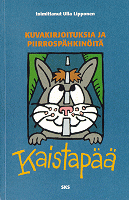|
Ulla Lipponen (Ed.) Kaistapää, Kuvakirjoituksia ja piirrospähkinöita (Pictorial puzzles and answers). Suomalainen Kirjallisuuden Seura. Helsinki 1999. 199 p. 
The subsequent anthology of Finnish children lore, compiled and edited by Ulla Lipponen, focuses on puzzles presented by graphical images and complements the two preceding anthologies published in the same series. Jauhot suuhun, or «Struck Dumb» (1995) contains mostly jocular riddles and conundrums, Sika sumussa, or «Pig in a Fog» (1997) contains riddles of the droodle type. The material of the third anthology could also be categorised as riddles, or, to be more particular, the subtypes of this genre, although the categorisation is far too general and requires further specification. The jocular purpose of most of the humorous and absurd riddles and answers is so manifest that they could be easily classified as anecdotes. In case of riddles of the droodle type, however, the comic purpose is less noticeable. The material of the third volume of the series serves primarily a playful function, the largest of the volume's 11 rubrics attracts the readers to solve rebuses (197 of the total 483 puzzles). Other riddles are divided into tiny rubrics on the basis of a dominant feature, according to the shape or material: puzzles with matchsticks (buttons, coins, etc.), manipulation with combinations of letters or figures, reckoning a person's age by the 'portrait' depicted in figures, etc. Other riddles, except rebuses, require additional oral formulation of the task, e.g.: How do you get two triangles by relocating two matchsticks? (no. 25); Use two straight lines to divide a horseshoe into separate parts with each part holding one nail (no. 136); Count the triangles on the figure (no. 144 -147); Point out the mismatching figure (no. 198); Draw a cat at one go. You cannot raise your pen from the paper, nor can you draw a line twice (no. 218); Form a square out of the pieces (no. 242); Which of the flowers is bigger? (no. 477). The compiler of the volume has opted out the attempt to subcategorise the material by reason of the obscure genre categorisation of the given material. For example, a rubric of tasks concerning optical illusion entitled «Would you believe your own eyes?» includes several riddles which might as well belong under the category of riddles of the droodle type (Nos. 463, 465, 470, 473,475, 478). U. Lipponen reveals in the afterword to the anthology that the material was contributed to the folklore archives largely from direct surveys among school children conducted on her own initiative or responses to written questionnaires during the past couple of years. Similar material has been contributed to the archives in the course of earlier collection work (1926, 1962, 1967). So, we are basically concerned with updating a phenomenon which in the early 20th century was registered as a hobby. The popular terminology available on the material is diverse, much as the material itself; there is no uniform term for it. Among some 25 introduced terms, some are based on genre, some on function, etc., which could be rendered as e.g. pictorial puzzle, riddle story, pictorial language, trick task, game of figures, matchstick story, intelligence test, etc. The border between riddles and children's games is obscure. Apparently, children are first introduced to the above mentioned riddles by the peer group, or learn them from elder children or grown-ups; sometimes, schoolteachers have given them trick tasks to solve, or they always have and continue to find them from publications. Although the Internet is widely used by today's schoolchildren, it is not mentioned as a mediator of lore. According to U. Lipponen the knowledge of the schoolchildren inquired varies considerably: some children might even collect similar material, while others cannot recall a single riddle. A survey conducted in 1987 among the correspondents of the folklore archives with a purpose to shed light on the earlier instances of graphically transmitted children lore revealed that the older generation was quite familiar with the subject. It turned out that the popularity of pictorial puzzles among our grandparents was mainly inspired by publications, various children's magazines, in particular. The instructions were the same as today: divide, subtract, continue, rank, add, join, etc. I should also point out that the principles of creating pictorial puzzles are universal, but the spread of puzzles, which require knowledge of language, like rebuses, from one nation to another is problematic due to language barriers. In the Estonian tradition rebuses should be regarded as a sub-category of riddles, strongly based on publications. With the boom of this riddle genre's 'periphery' during 1970-1990, the use of rebuses and other trick tasks enlivened, but not to the extent as the use of absurd riddles and riddles of the droodle type, where the contribution of printed publications for their formation and spread was practically non-existent. Today's researchers are interested in studying the importance of printed word as a magnifier, but also the significance of audio-tapes as a means for transmitting, say, authorial songs in the course of folkloric processes, and Internet as the mediator of jokes, etc. U. Lipponen's Kaistapää anthology provides at least two arguments justifying the folkloric research into the material found in printed publications: its spread, which is characteristic to folklore, and the simultaneous use of new and modern associative notions (cf. e.g. the keywords of today like Elvis Presley, Opel, hot dog, ice-cream, tent, T-shirt, etc.). Mall Hiiemäe, Tartu
|